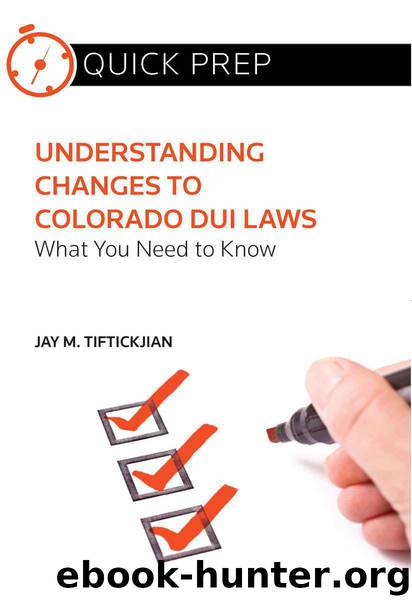Understanding Changes to Colorado DUI Laws: What You Need to Know (Quick Prep) by Tiftickjian Jay M

Author:Tiftickjian, Jay M. [Tiftickjian, Jay M.]
Language: eng
Format: epub
Publisher: Thomson Reuters
Published: 2014-03-31T16:00:00+00:00
5
Evidence
* * *
There are generally four phases to a DUI investigation: driving, initial contact, field sobriety tests, and finally, chemical tests.
Driving
In almost all DUI cases, motorists are stopped either because of something the officer claims they did wrong or contacted as the result of an accident. Both the circumstances of the accident and the driving might be good or bad evidence.
To prove DUI or DWAI, the prosecutor must convince the jury, beyond a reasonable doubt, that the defendant was less able than he or she ordinarily would have been to operate a motor vehicle. One of the major determining factors for a jury is what the driving was like before police contact.
In most circumstances, motorists are contacted after being stopped for a traffic violation. To stop a driver legally, an officer must have a “reasonable suspicion” that the driver committed or is committing a crime. The crime can be as minor as a traffic infraction or equipment violation. Once the officer contacts the driver and observes signs of impairment, the encounter will turn into a DUI investigation.
Most police officers are trained to investigate and work driving cases based on the materials published by the National Highway Traffic Safety Administration (NHTSA). This agency provides driving “cues” of impaired driving in its training materials. Currently twenty-four cues indicate impaired driving: 1 3
Problems Maintaining Proper Lane Position
• Weaving
• Weaving across lane lines
• Straddling a lane line
• Swerving
• Turning with a wide radius
• Drifting
• Almost striking a vehicle or other object
Speed and Braking Problems
• Stopping problems (too far, too short, or too jerky)
• Accelerating or decelerating for no apparent reason
• Varying speed
• Slow speed (10+ miles per hour under limit)
Vigilance Problems
• Driving in opposing lanes or wrong way on one-way
• Slow response to traffic signals
• Slow or failure to respond to officer’s signals
• Stopping in lane for no apparent reason
• Driving without headlights at night
• Failure to signal or signal inconsistent with action
Judgment Problems
• Following too closely
• Improper or unsafe lane change
• Illegal or improper turn (too fast, jerky, sharp, etc.)
• Driving elsewhere other than the designated roadway
• Stopping inappropriately in response to the officer
• Inappropriate or unusual behavior (throwing, arguing, etc.)
• Appearing to be impaire d
It should be noted that not exhibiting cues does not mean the prosecution cannot prove its case, nor does it mean that any one of the above violations occurs only when a driver is impaired. If a driver did not commit any of the above offenses and was contacted for some other reason, such as speeding, the DUI investigation likely began because the officer started to suspect impairment when he or she first contacted the driver.
Initial Contact
If an officer believes a driver may be under the influence, the officer will look for other indicators of impairment. NHTSA alleges the cues listed below are indicative of impaired driving: 14
Post-Stop Cues
• Difficulty with motor vehicle controls
• Difficulty exiting the vehicle
• Fumbling with driver’s license or registration
• Repeating questions or comments
• Swaying, unsteadiness, or balance problems
• Leaning on the vehicle or
Download
This site does not store any files on its server. We only index and link to content provided by other sites. Please contact the content providers to delete copyright contents if any and email us, we'll remove relevant links or contents immediately.
The Borden Murders by Sarah Miller(4025)
The Secret Barrister by The Secret Barrister(3425)
Coroner's Journal by Louis Cataldie(2361)
Police Exams Prep 2018-2019 by Kaplan Test Prep(2361)
The Splendid and the Vile by Erik Larson(2231)
Terrorist Cop by Mordecai Dzikansky & ROBERT SLATER(1965)
My Dark Places by James Ellroy(1806)
A Colony in a Nation by Chris Hayes(1797)
Black Klansman by Ron Stallworth(1705)
The Art of Flight by unknow(1697)
A Life of Crime by Harry Ognall(1597)
Objection! by Nancy Grace(1572)
The New Jim Crow by Michelle Alexander(1552)
Whoever Fights Monsters by Robert K. Ressler(1538)
Anatomy of Injustice by Raymond Bonner(1532)
Invisible Women by Caroline Criado Perez;(1521)
Obsession (The Volkov Mafia Series Book 1) by S.E Foster(1497)
American Prison by Shane Bauer(1481)
A is for Arsenic: The Poisons of Agatha Christie (Bloomsbury Sigma) by Kathryn Harkup(1458)
